Abstract
OBJECTIVE--To conduct a field study to obtain information on the urinary concentrations of aluminium (Al) and fluoride (F-) depending on the different compounds exposed to in the aluminum industry. METHODS--16 workers from one plant that produced aluminium fluoride (AlF3), and from two plants that produced aluminium electrolytically by two different processes participated in the study for one working week. Pollutants were monitored by eight hour personal sampling every day, and urine samples were collected during the week. Al and F- were analysed in both atmospheric and urine samples by atomic absorption spectrometry and an ion selective electrode. RESULTS--The principal results show different characteristics of kinetic curves of Al and F- excretion in workers with different exposures. Some characteristics of excretory peaks were linked to specific exposures--for instance, after exposure to AlF3 there was one delayed Al peak associated with one delayed F- peak about eight hours after the end of the daily shift, and after mixed exposure to HF and AlF3, two F- peaks were noted, one fast peak at the end of the shift and another delayed peak at 10 hours synchronised with an Al peak. In one of the electrolysis plants, the exposure to Al and F- compounds led to the simultaneous excretion of Al and F- peaks, either as a single peak or two individual ones depending on the type of technology used on site (open or enclosed potlines). The average estimated half life of Al was 7.5 hours, and of F- about nine hours. Quantitative relations between excretion and exposure showed an association between the F- atmospheric limit value of 2.5 mg/m3 with a urinary F- concentration of 6.4 mg/g creatinine at the end of the shift, a peak of 7.4 mg/g creatinine, and 7.4 mg excreted a day. For Al, the exposure to 1.36 mg/m3 during the shift corresponded to a urinary concentration at the end of the shift of 200 microgram/g creatinine. Daily excretion of 200 micrograms corresponded to an exposure to 0.28 mg/m3. CONCLUSION--Particular differences in the behaviour of Al and F- in urine depended upon the original molecular form in the pollutant. These results reinforce the principle that, in biological monitoring, the sampling strategy and the choice of limit value should be dependent on kinetic data that take the exposure compound of the element in question into account.
Full text
PDF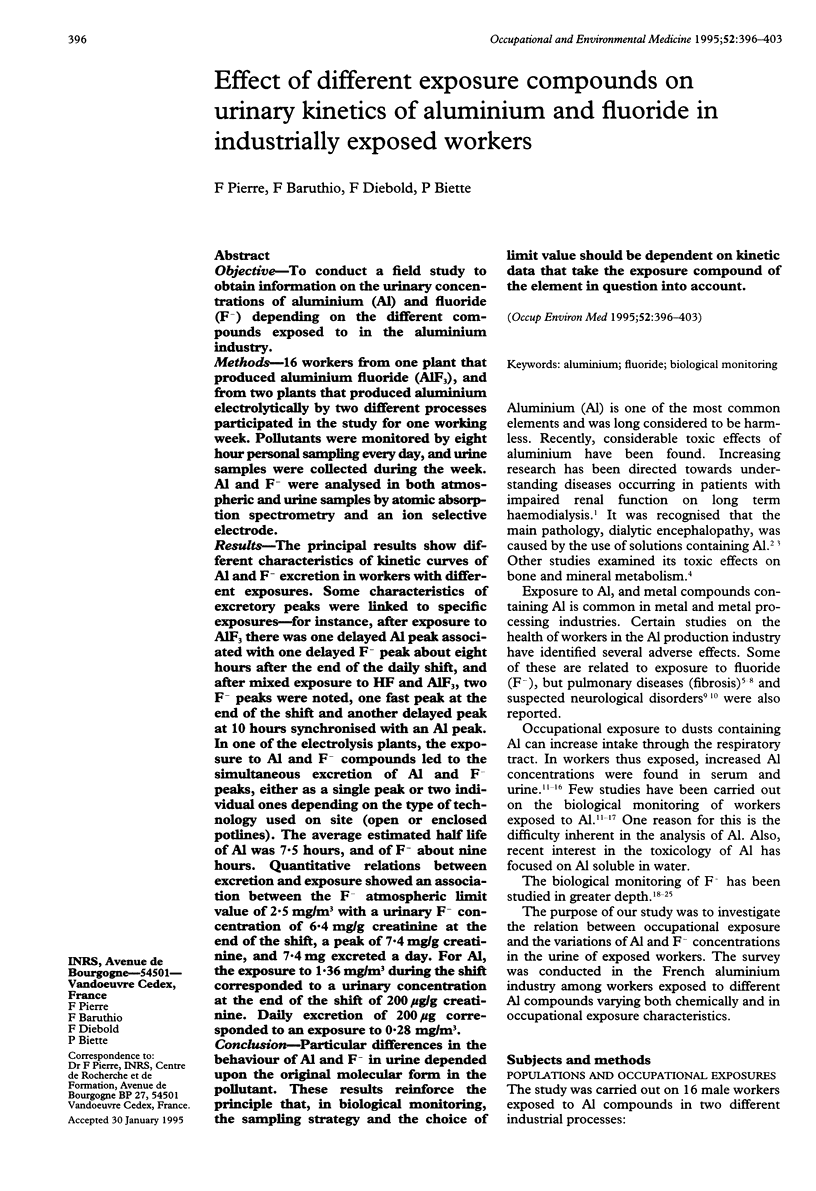
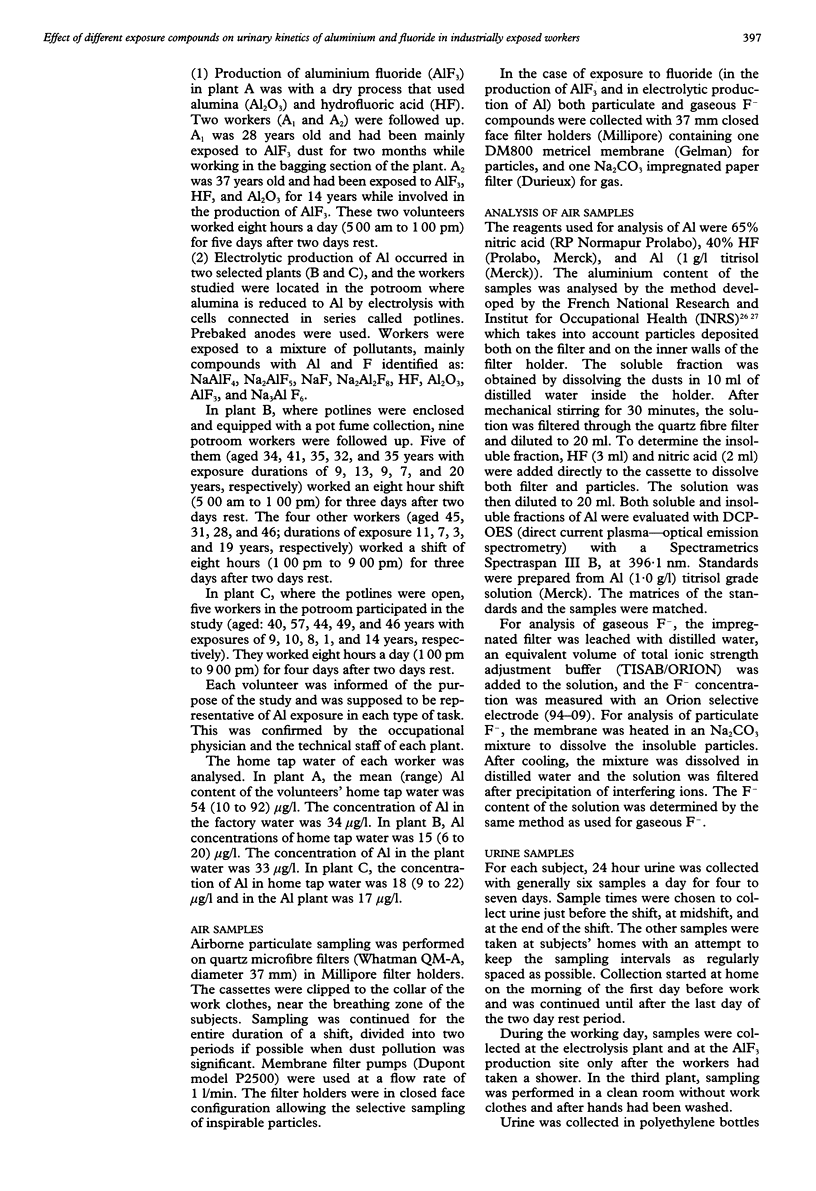
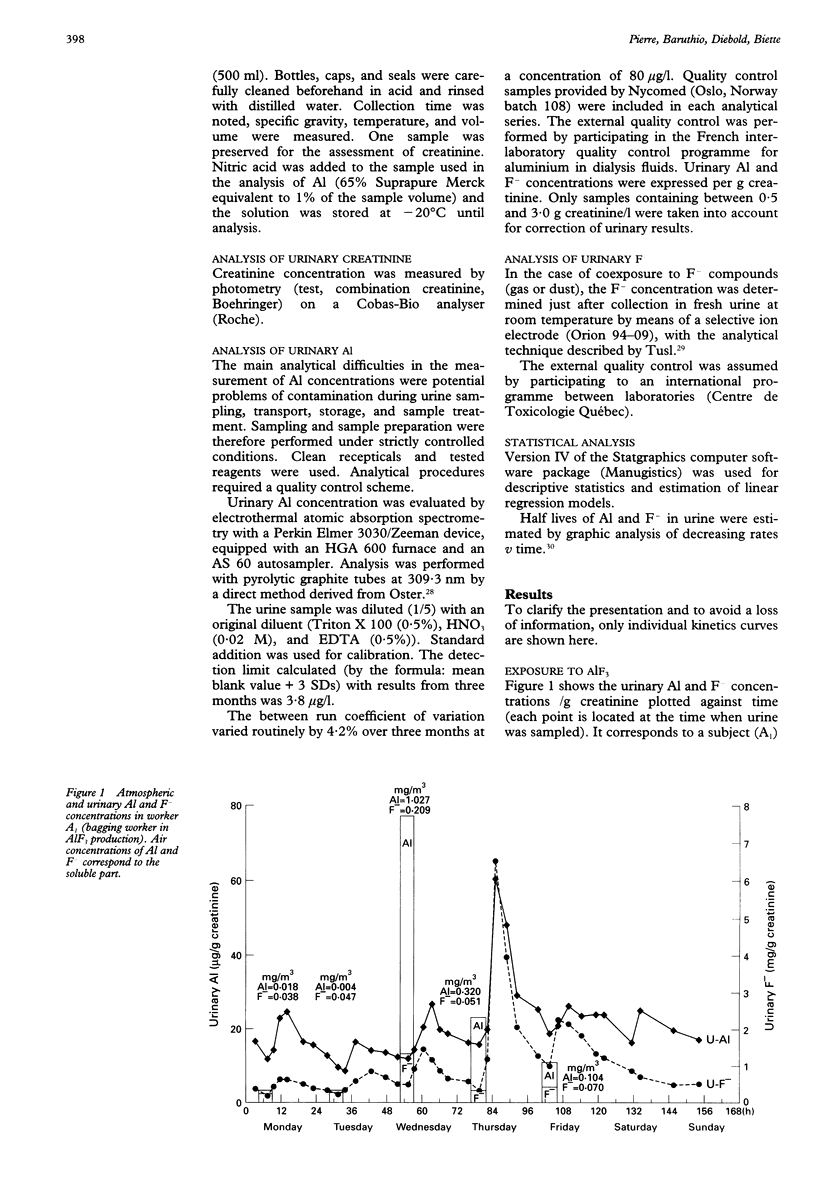
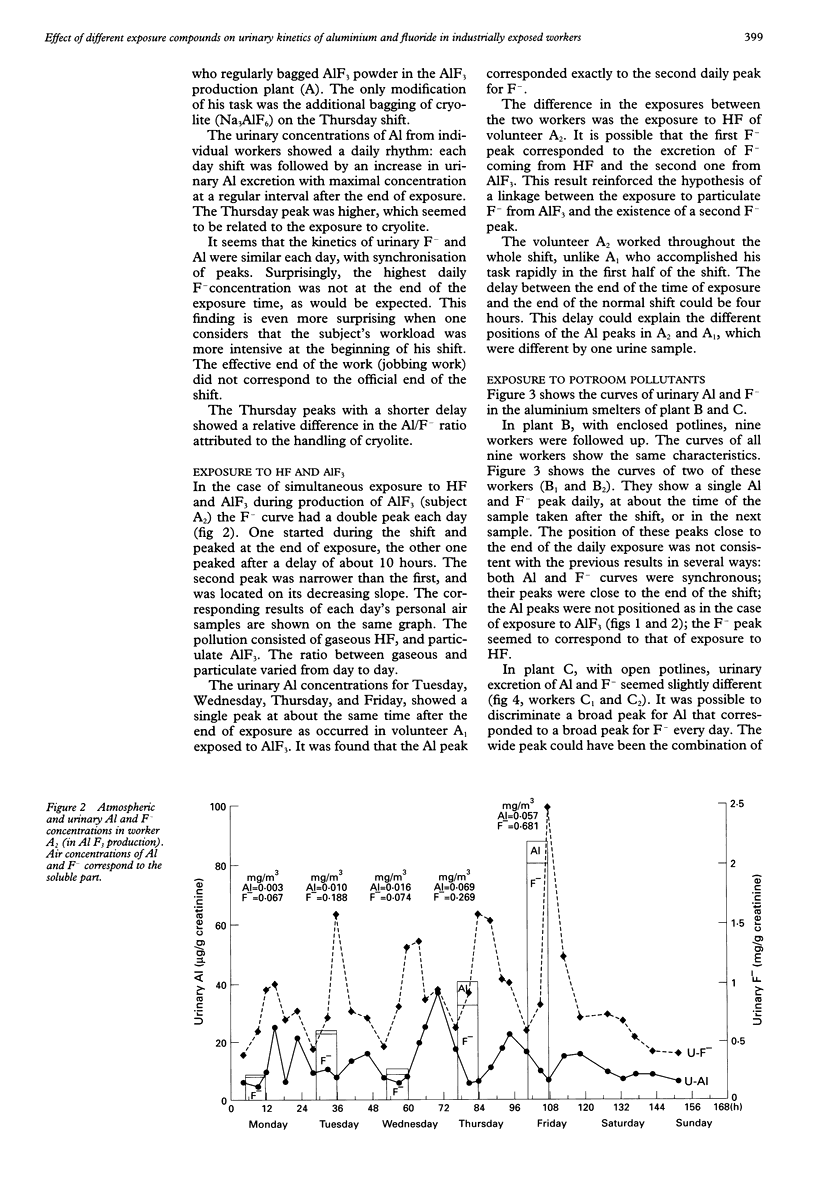
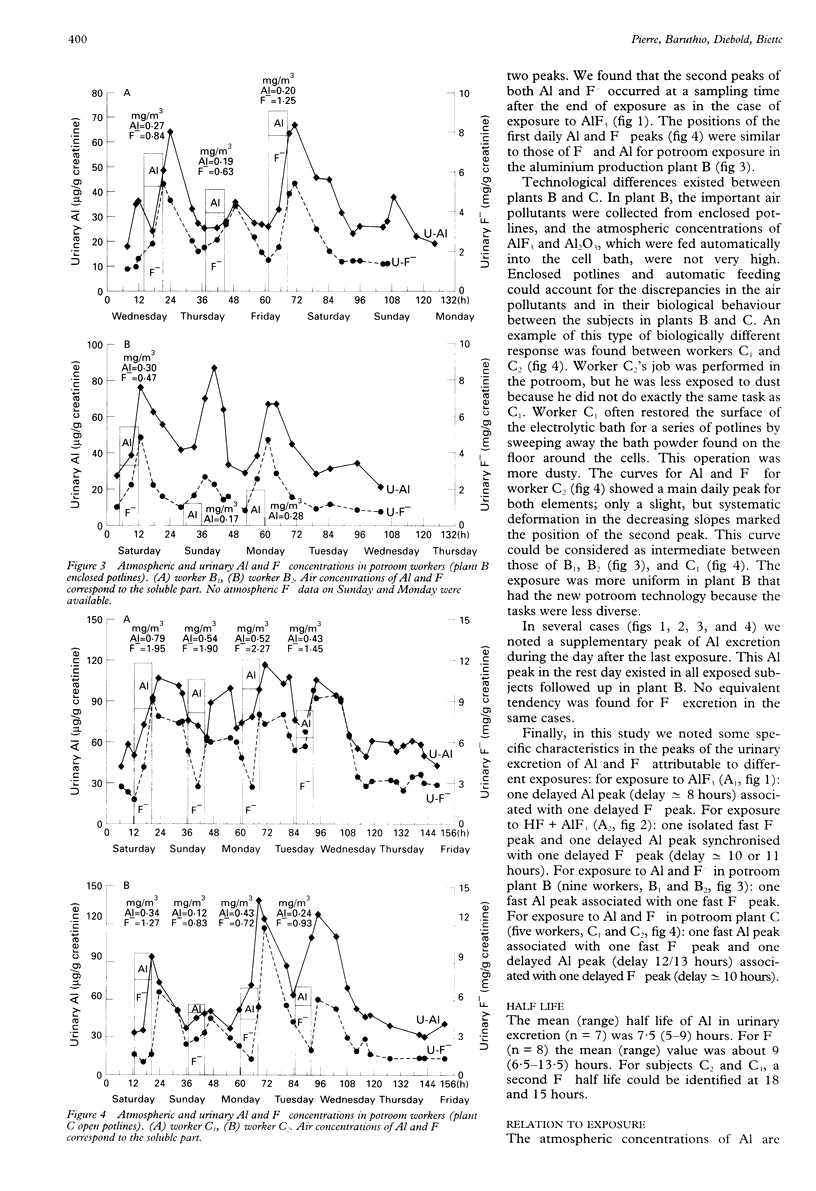
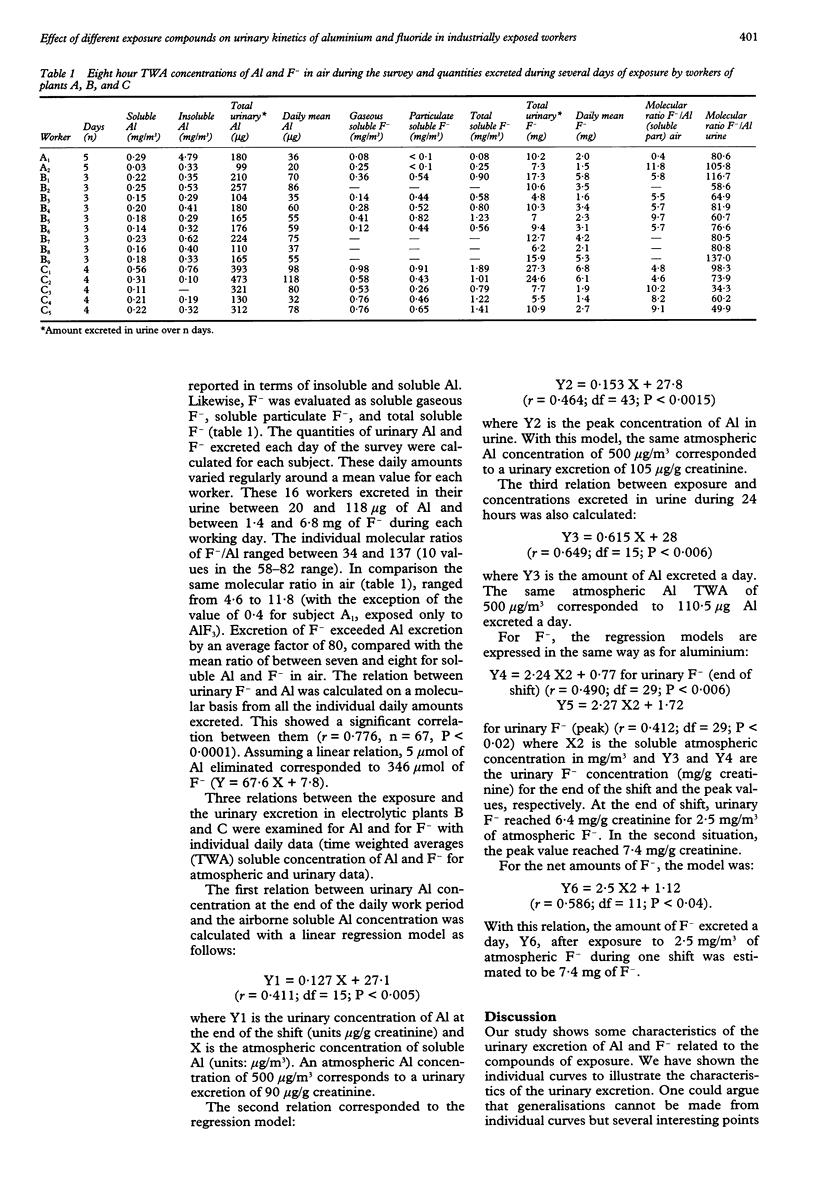
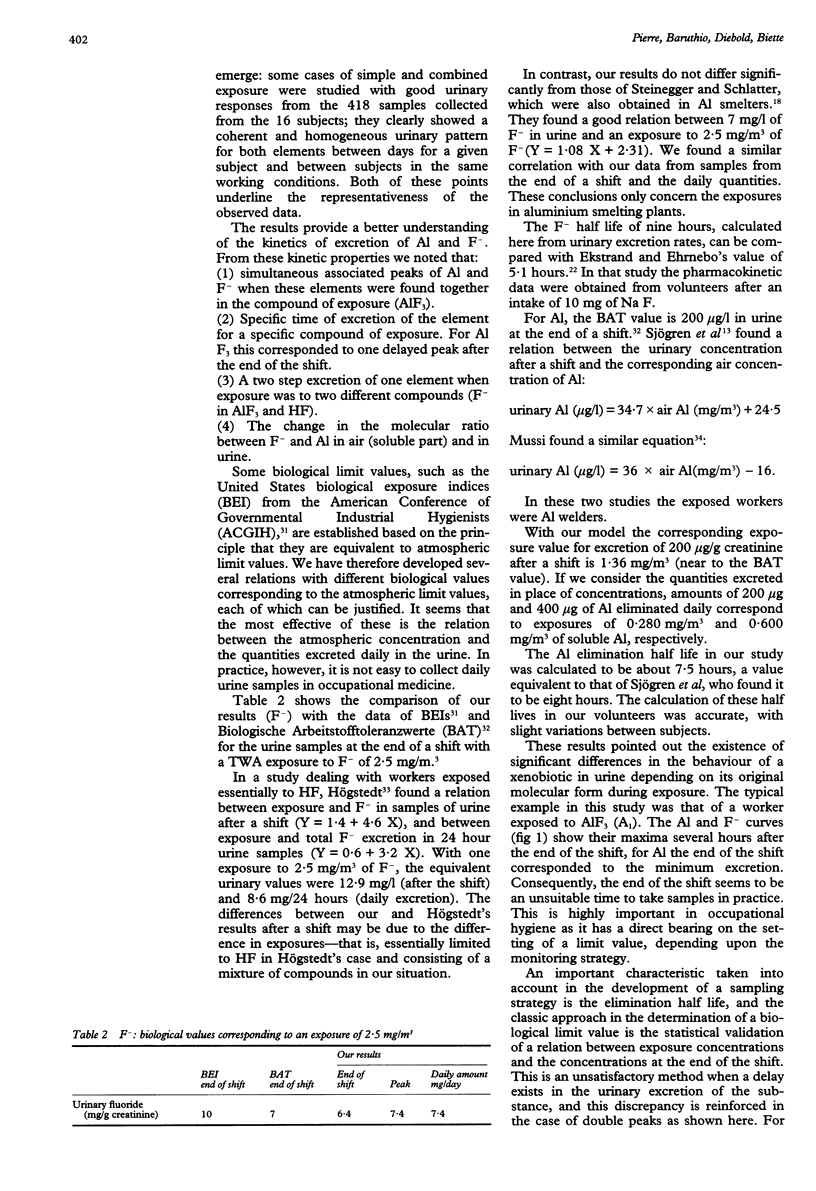
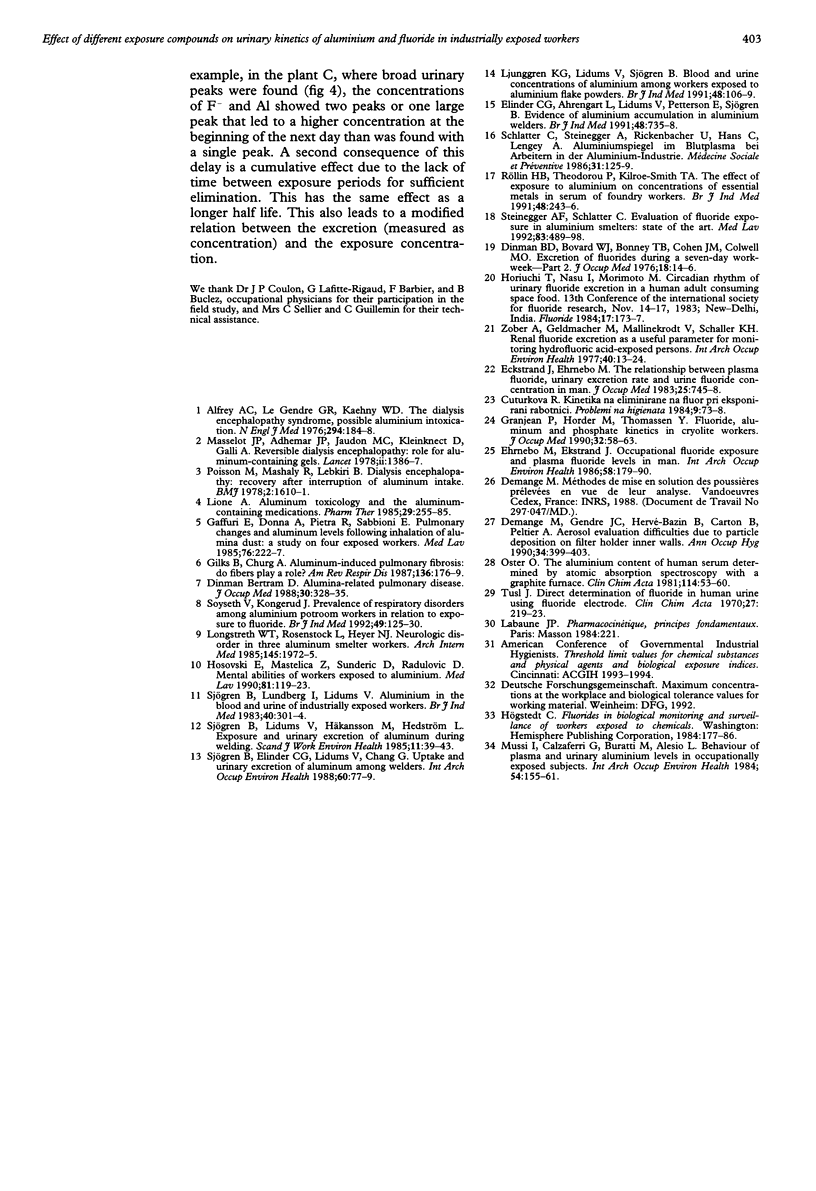
Selected References
These references are in PubMed. This may not be the complete list of references from this article.
- Alfrey A. C., LeGendre G. R., Kaehny W. D. The dialysis encephalopathy syndrome. Possible aluminum intoxication. N Engl J Med. 1976 Jan 22;294(4):184–188. doi: 10.1056/NEJM197601222940402. [DOI] [PubMed] [Google Scholar]
- Dinman B. D. Alumina-related pulmonary disease. J Occup Med. 1988 Apr;30(4):328–335. [PubMed] [Google Scholar]
- Dinman B. D., Bovard W. J., Bonney T. B., Cohen J. M., Colwell M. O. Prevention of bony fluorosis in aluminum smelter workers. Excretion of fluorides during a seven-day workweek -- Pt. 2. J Occup Med. 1976 Jan;18(1):14–16. [PubMed] [Google Scholar]
- Ehrnebo M., Ekstrand J. Occupational fluoride exposure and plasma fluoride levels in man. Int Arch Occup Environ Health. 1986;58(3):179–190. doi: 10.1007/BF00432099. [DOI] [PubMed] [Google Scholar]
- Ekstrand J., Ehrnebo M. The relationship between plasma fluoride, urinary excretion rate and urine fluoride concentration in man. J Occup Med. 1983 Oct;25(10):745–748. doi: 10.1097/00043764-198310000-00014. [DOI] [PubMed] [Google Scholar]
- Elinder C. G., Ahrengart L., Lidums V., Pettersson E., Sjögren B. Evidence of aluminium accumulation in aluminium welders. Br J Ind Med. 1991 Nov;48(11):735–738. doi: 10.1136/oem.48.11.735. [DOI] [PMC free article] [PubMed] [Google Scholar]
- Gaffuri E., Donna A., Pietra R., Sabbioni E. Pulmonary changes and aluminium levels following inhalation of alumina dust: a study on four exposed workers. Med Lav. 1985 May-Jun;76(3):222–227. [PubMed] [Google Scholar]
- Gilks B., Churg A. Aluminum-induced pulmonary fibrosis: do fibers play a role? Am Rev Respir Dis. 1987 Jul;136(1):176–179. doi: 10.1164/ajrccm/136.1.176. [DOI] [PubMed] [Google Scholar]
- Grandjean P., Hørder M., Thomassen Y. Fluoride, aluminum, and phosphate kinetics in cryolite workers. J Occup Med. 1990 Jan;32(1):58–63. doi: 10.1097/00043764-199001000-00015. [DOI] [PubMed] [Google Scholar]
- Hosovski E., Mastelica Z., Sunderić D., Radulović D. Mental abilities of workers exposed to aluminium. Med Lav. 1990 Mar-Apr;81(2):119–123. [PubMed] [Google Scholar]
- Leathwood P. D., Plummer D. T. Starch block electrophoresis of lactate dehydrogenase isoenzymes in phosphate buffer. Clin Chim Acta. 1970 Jan;27(1):219–221. doi: 10.1016/0009-8981(70)90401-8. [DOI] [PubMed] [Google Scholar]
- Lione A. Aluminum toxicology and the aluminum-containing medications. Pharmacol Ther. 1985;29(2):255–285. doi: 10.1016/0163-7258(85)90032-4. [DOI] [PubMed] [Google Scholar]
- Longstreth W. T., Jr, Rosenstock L., Heyer N. J. Potroom palsy? Neurologic disorder in three aluminum smelter workers. Arch Intern Med. 1985 Nov;145(11):1972–1975. doi: 10.1001/archinte.145.11.1972. [DOI] [PubMed] [Google Scholar]
- Masselot J. P., Adhemar J. P., Jaudon M. C., Kleinknecht D., Galli A. Reversible dialysis encephalopathy: role for aluminium-containing gels. Lancet. 1978 Dec 23;2(8104-5):1386–1387. doi: 10.1016/s0140-6736(78)92031-7. [DOI] [PubMed] [Google Scholar]
- Mussi I., Calzaferri G., Buratti M., Alessio L. Behaviour of plasma and urinary aluminium levels in occupationally exposed subjects. Int Arch Occup Environ Health. 1984;54(2):155–161. doi: 10.1007/BF00378518. [DOI] [PubMed] [Google Scholar]
- Oster O. The aluminium content of human serum determined by atomic absorption spectroscopy with a graphite furnace. Clin Chim Acta. 1981 Jul 18;114(1):53–60. doi: 10.1016/0009-8981(81)90227-8. [DOI] [PubMed] [Google Scholar]
- Poisson M., Mashaly R., Lebkiri B. Dialysis encephalopathy: recovery after interruption of aluminium intake. Br Med J. 1978 Dec 9;2(6152):1610–1611. doi: 10.1136/bmj.2.6152.1610. [DOI] [PMC free article] [PubMed] [Google Scholar]
- Röllin H. B., Theodorou P., Kilroe-Smith T. A. The effect of exposure to aluminium on concentrations of essential metals in serum of foundry workers. Br J Ind Med. 1991 Apr;48(4):243–246. doi: 10.1136/oem.48.4.243. [DOI] [PMC free article] [PubMed] [Google Scholar]
- Schlatter C., Steinegger A., Rickenbacher U., Hans C., Lengeyl A. Aluminiumspiegel im Blutplasma bei Arbeitern in der Aluminium-Industrie. Soz Praventivmed. 1986;31(2):125–129. doi: 10.1007/BF02091603. [DOI] [PubMed] [Google Scholar]
- Sjögren B., Elinder C. G., Lidums V., Chang G. Uptake and urinary excretion of aluminum among welders. Int Arch Occup Environ Health. 1988;60(2):77–79. doi: 10.1007/BF00381484. [DOI] [PubMed] [Google Scholar]
- Sjögren B., Lidums V., Håkansson M., Hedström L. Exposure and urinary excretion of aluminum during welding. Scand J Work Environ Health. 1985 Feb;11(1):39–43. doi: 10.5271/sjweh.2255. [DOI] [PubMed] [Google Scholar]
- Sjögren B., Lundberg I., Lidums V. Aluminium in the blood and urine of industrially exposed workers. Br J Ind Med. 1983 Aug;40(3):301–304. doi: 10.1136/oem.40.3.301. [DOI] [PMC free article] [PubMed] [Google Scholar]
- Steinegger A. F., Schlatter C. Evaluation of fluoride exposure in aluminium smelters: state of the art. Med Lav. 1992 Sep-Oct;83(5):489–498. [PubMed] [Google Scholar]
- Søyseth V., Kongerud J. Prevalence of respiratory disorders among aluminium potroom workers in relation to exposure to fluoride. Br J Ind Med. 1992 Feb;49(2):125–130. doi: 10.1136/oem.49.2.125. [DOI] [PMC free article] [PubMed] [Google Scholar]
- Zober A., Geldmacher von Mallinckrodt M., Schaller K. H. Renal fluoride excretion as a useful parameter for monitoring hydrofluoric acid-exposed persons. Int Arch Occup Environ Health. 1977 Oct 17;40(1):13–24. doi: 10.1007/BF00435513. [DOI] [PubMed] [Google Scholar]


